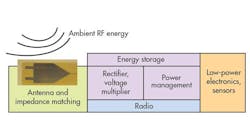Due to the proliferation of sensors, these devices are beginning to fully embrace disposable packaging. Concerns over the environmental impact of RFID and wireless-sensor-network technologies, however, demand the development of environmentally conscious antenna solutions that are also cost-effective. To meet this future need, an inkjet-printed wideband planar monopole antenna on thin cardboard packaging has been designed and tested by researchers Hossein Saghlatoon, Toni Bjorninen, Lauri Sydanheimo, and Leena Ukkonen from Finland’s Tempere University of Technology, together with Manos M. Tentzeris from the Georgia Institute of Technology in Atlanta.
The researchers first had to choose viable materials that would perform well in fabricated and efficient power-harvesting technology while maintaining high standards of environmental safety. Naturally, already environmentally degradable and safe materials were chosen—fibrous cardboard and silver nanoparticles. To keep costs low, they decided to use common and cost-efficient inkjet printing processes.
The challenge of developing a conformal planar monopole antenna was exacerbated by the uneven and fibrous roughness of the cardboard surface. A coating for the cardboard using the same inkjet process was developed. As a result, the nanoparticles could then be deposited conformably with a significant efficiency increase. In experimental results, the antenna harvesting energy from 800 to 1500 MHz exhibited a minimum of 72% efficiency. Although this is substantially lower than the simulated efficiencies of 92%, the desired efficiency levels were achieved—even considering a variable conformity to the cardboard structure. See “Inkjet-Printed Wideband Planar Monopole Antenna on Cardboard for RF Energy-Harvesting Applications,” IEEE Antennas and Wireless Propagation Letters, Oct. 2014, p. 325-328.

